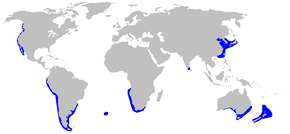bio.wikisort.org - Animal
Requin plat-nez
Notorynchus cepedianus
Requin plat-nez
| Règne | Animalia |
|---|---|
| Embranchement | Chordata |
| Sous-embr. | Vertebrata |
| Super-classe | Gnathostomata |
| Super-classe | Pisces |
| Classe | Elasmobranchii |
| Sous-classe | Neoselachii |
| Infra-classe | Selachii |
| Super-ordre | Squalomorphi |
| Ordre | Hexanchiformes |
| Famille | Hexanchidae |
| Genre | Notorynchus |
Espèce
Synonymes
- Heptanchus indicus (Agassiz, 1838)[2] [3]
- Heptanchus pectorosus (Garman, 1884)[2] [3]
- Heptrachias pectorosus Garman, 1884[2] [3]
- Heptranchias cepedianus (Péron, 1807)[2] [3]
- Heptranchias haswelli Ogilby, 1897[2] [3]
- Heptranchias pectorosus Garman, 1884[2] [3]
- Heptranchias spilotus Lahille, 1913[2] [3]
- Notidanus ferox Perez Canto, 1886[3]
- Notidanus ferox Pérez Canto, 1886[2]
- Notidanus indicus Agassiz, 1838[2] [3]
- Notidanus medinae Philippi, 1902[2] [3]
- Notidanus wolniczkyi Philippi, 1902[2]
- Notorhynchus borealis Gill, 1864[2]
- Notorhynchus cepedianus (Péron, 1807)[2]
- Notorhynchus maculatus Ayres, 1855[2]
- Notorhynchus ocellatus Devincenzi, 1920[2]
- Notorhynchus platycephalus (Tenore, 1809)[2]
- Notorynchus indicus (Agassiz, 1838)[2]
- Notorynchus macdonaldi Whitley, 1931[2]
- Notorynchus maculatum Ayres, 1855[2]
- Notorynchus maculatus Ayres, 1855[2]
- Notorynchus pectorosus (Garman, 1884)[2]
- Notorynchus platycephalus (Tenore, 1809)[2]
- Squalus cepedianus Péron, 1807[2] [4]
- Squalus platycephalus Tenore, 1809[2]
Statut de conservation UICN
DD : Données insuffisantes
Répartition géographique

Le requin plat-nez, Notorynchus cepedianus, est une espèce de requins primitifs possédant 7 paires de fentes branchiales. Il vit dans l'Atlantique et le Pacifique, de la surface à -570 mètres. Il peut atteindre 3,50 mètres de long et vivre 50 ans.
C’est la seule espèce actuelle du genre Notorynchus qui comprend aussi des espèces fossiles.
Répartition géographique

On le rencontre dans la majorité des mers tempérées.
Notes et références
Références taxinomiques
- (en) Référence Animal Diversity Web : Notorynchus cepedianus (consulté le )
- (en) Référence Fonds documentaire ARKive : Notorynchus cepedianus (consulté le )
- (en) Référence BioLib : Notorynchus cepedianus (Péron, 1807) (consulté le )
- (en) Référence Catalogue of Life : Notorynchus cepedianus (Péron, 1807) (consulté le )
- (fr+en) Référence FishBase : (consulté le )
- (fr+en) Référence ITIS : Notorynchus cepedianus (Péron, 1807) (consulté le )
- (en) Référence NCBI : Notorynchus cepedianus (taxons inclus) (consulté le )
- (en) Référence uBio : Notorynchus cepedianus (Péron, 1807) (consulté le )
- (en) Référence UICN : espèce Notorynchus cepedianus (Péron, 1807) (consulté le )
- (en) Référence World Register of Marine Species : espèce Notorynchus cepedianus (Péron, 1807) (consulté le )
Lien externe
- Portail de l’ichtyologie
- Portail des abysses
На других языках
[en] Broadnose sevengill shark
The broadnose sevengill shark (Notorynchus cepedianus) is the only extant member of the genus Notorynchus, in the family Hexanchidae. It is recognizable because of its seven gill slits, while most shark species have five gill slits, with the exception of the members of the order Hexanchiformes and the sixgill sawshark. This shark has a large, thick body, with a broad head and blunt snout. The top jaw has jagged, cusped teeth and the bottom jaw has comb-shaped teeth. Its single dorsal fin is set far back along the spine towards the caudal fin, and is behind the pelvic fins. In this shark the upper caudal fin is much longer than the lower, and is slightly notched near the tip. Like many sharks, this sevengill is counter-shaded. Its dorsal surface is silver-gray to brown in order to blend with the dark water and substrate when viewed from above. In counter to this, its ventral surface is very pale, blending with the sunlit water when viewed from below. The body and fins are covered in a scattering of small black & white spots. In juveniles, their fins often have white margins.- [fr] Notorynchus cepedianus
[ru] Плоскоголовая семижаберная акула
Плоскоголовая семижаберная акула[1][2] или плоскоголовый многожаберник[1] (лат. Notorynchus cepedianus) — единственный современный вид рода семижаберных акул Плоскоголовые акулы[1], Плоскоголовые семижаберники[3] или Плоскоголовые многожаберники[1] (Notorynchus) из семейства многожаберных акул. Характерной особенностью этого вида является наличие 7 пар жаберных щелей, в то время как у большинства видов акул, за исключением представителей семейства многожаберных акул и пилоносой акулы, по 5 пар жаберных щелей. У плоскоголовой семижаберной акулы крупное и плотное тело с широкой головой. Верхние зубы имеют центральное остриё, нижние по форме напоминают гребёнку. Единственный спинной плавник сдвинут к хвосту. Окрас от серебристо-серого до коричневого цвета. Обитает повсеместно в умеренных водах. Максимальная зафиксированная длина составляет 2,9 м. Это донный неритический и морской вид. Является объектом коммерческой и любительской добычи[4].Текст в блоке "Читать" взят с сайта "Википедия" и доступен по лицензии Creative Commons Attribution-ShareAlike; в отдельных случаях могут действовать дополнительные условия.
Другой контент может иметь иную лицензию. Перед использованием материалов сайта WikiSort.org внимательно изучите правила лицензирования конкретных элементов наполнения сайта.
Другой контент может иметь иную лицензию. Перед использованием материалов сайта WikiSort.org внимательно изучите правила лицензирования конкретных элементов наполнения сайта.
2019-2025
WikiSort.org - проект по пересортировке и дополнению контента Википедии
WikiSort.org - проект по пересортировке и дополнению контента Википедии
